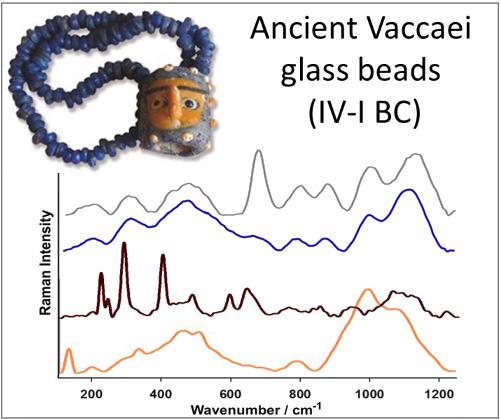当前位置:
X-MOL 学术
›
J. Raman Spectrosc.
›
论文详情
Our official English website, www.x-mol.net, welcomes your
feedback! (Note: you will need to create a separate account there.)
Investigating glass beads and the funerary rituals of ancient Vaccaei culture (S. IV‐I BC) by Raman spectroscopy
Journal of Raman Spectroscopy ( IF 2.4 ) Pub Date : 2020-11-22 , DOI: 10.1002/jrs.6049 J. Pinto 1, 2 , A.C. Prieto 1, 2, 3 , J.C. Coria‐Noguera 1, 4 , C. Sanz‐Minguez 1, 2 , J. Souto 1, 3
Journal of Raman Spectroscopy ( IF 2.4 ) Pub Date : 2020-11-22 , DOI: 10.1002/jrs.6049 J. Pinto 1, 2 , A.C. Prieto 1, 2, 3 , J.C. Coria‐Noguera 1, 4 , C. Sanz‐Minguez 1, 2 , J. Souto 1, 3
Affiliation

|
Glass pieces were highly appreciated goods in the Protohistory of the Iberian Peninsula. The specialized production of these glass pieces seems noncompatible with local workshops, and therefore, they are proof of commercial relationships with other cultures with the technical capability to produce such pieces. However, detailed studies of glass beads of archaeological relevance are scarce, as these samples usually appeared without a clear historical context. Nevertheless, the archaeological site of Pintia (Padilla de Duero, Valladolid, Spain) is a relevant exception to this situation. About 600 pieces have been recovered by 2018, with a significant percentage found in closed tombs. In this work, a set of 15 representative pieces from the Vaccaei culture (IV‐I centuries BC) have been studied by Raman spectroscopy and ESEM/EDX. The combination of both techniques provided valuable information about the fabrication of these samples, identifying diverse features that could be related to different workshops or origins. In particular, the characteristics of a sophisticated bifacial pendant were found to be compatible with their provenance from Carthage. Also, some of the pigments employed on these samples were identified by Raman spectroscopy, finding lead oxides, calcium antimoniate, hematite, and Naples yellow. The diverse trousseaus and viatic offerings found in the Vaccaei tombs show the relevance and complexity of the funerary cremation rituals in their culture. The study by Raman spectroscopy of well‐preserved and thermally altered glass beads found in the same tomb allowed estimating the maximum temperature reached during the cremation in about 600°C, which confirmed previous estimations derived from the state of conservation of the bone remains.
中文翻译:

用拉曼光谱法研究古代瓦卡伊文化(S.IV-I BC)的玻璃珠和葬礼
在伊比利亚半岛的原始历史中,玻璃碎片是备受赞赏的商品。这些玻璃碎片的专业化生产似乎与当地的车间不兼容,因此,它们证明了与具有这种玻璃碎片生产技术能力的其他文化的商业关系。但是,对于与考古相关的玻璃珠的详细研究很少,因为这些样品通常在没有明确历史背景的情况下出现。尽管如此,Pintia的考古遗址(西班牙巴利亚多利德的Padilla de Duero)是这种情况的一个相关例外。到2018年,已回收了约600件作品,其中很大一部分是在封闭的坟墓中发现的。在这项工作中,通过拉曼光谱法和ESEM / EDX研究了一组15个来自瓦卡伊文化(公元前一世纪到公元前)的代表性作品。两种技术的结合提供了有关这些样品制造的有价值的信息,确定了可能与不同的车间或起源有关的各种特征。特别是,发现复杂的双面吊坠的特性与其来自迦太基的出身相吻合。另外,通过拉曼光谱法鉴定了这些样品上使用的某些颜料,发现了氧化铅,锑酸钙,赤铁矿和那不勒斯黄。瓦卡伊墓中发现的多样的海参和玻璃瓶祭品表明了其文化中丧葬火葬仪式的相关性和复杂性。通过拉曼光谱法对在同一座坟墓中发现的保存完好的和热变的玻璃珠的研究可以估算出火化过程中达到的最高温度约为600°C,
更新日期:2021-01-16
中文翻译:

用拉曼光谱法研究古代瓦卡伊文化(S.IV-I BC)的玻璃珠和葬礼
在伊比利亚半岛的原始历史中,玻璃碎片是备受赞赏的商品。这些玻璃碎片的专业化生产似乎与当地的车间不兼容,因此,它们证明了与具有这种玻璃碎片生产技术能力的其他文化的商业关系。但是,对于与考古相关的玻璃珠的详细研究很少,因为这些样品通常在没有明确历史背景的情况下出现。尽管如此,Pintia的考古遗址(西班牙巴利亚多利德的Padilla de Duero)是这种情况的一个相关例外。到2018年,已回收了约600件作品,其中很大一部分是在封闭的坟墓中发现的。在这项工作中,通过拉曼光谱法和ESEM / EDX研究了一组15个来自瓦卡伊文化(公元前一世纪到公元前)的代表性作品。两种技术的结合提供了有关这些样品制造的有价值的信息,确定了可能与不同的车间或起源有关的各种特征。特别是,发现复杂的双面吊坠的特性与其来自迦太基的出身相吻合。另外,通过拉曼光谱法鉴定了这些样品上使用的某些颜料,发现了氧化铅,锑酸钙,赤铁矿和那不勒斯黄。瓦卡伊墓中发现的多样的海参和玻璃瓶祭品表明了其文化中丧葬火葬仪式的相关性和复杂性。通过拉曼光谱法对在同一座坟墓中发现的保存完好的和热变的玻璃珠的研究可以估算出火化过程中达到的最高温度约为600°C,











































 京公网安备 11010802027423号
京公网安备 11010802027423号